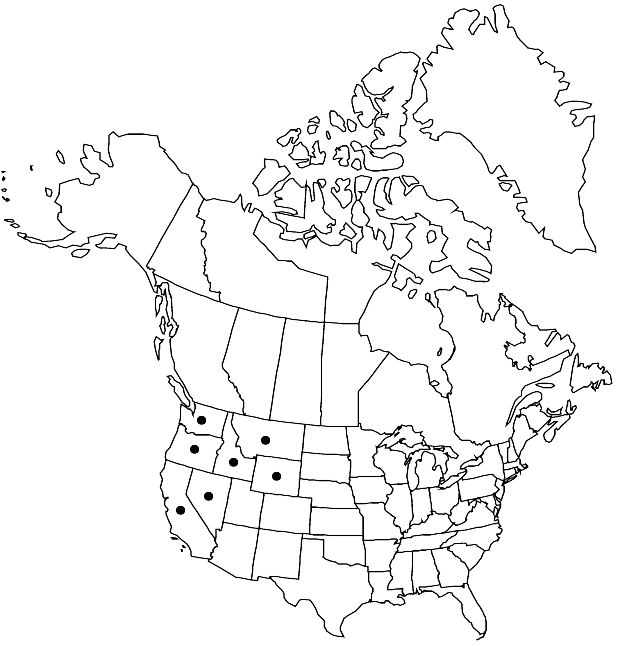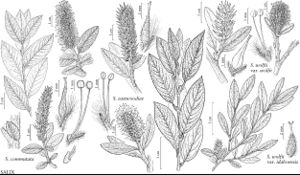Salix eastwoodiae
Cat. N. Amer. Pl. ed. 3, 89. 1910.
Plants 0.6–4 m. Stems: branches yellow, red, or violet, not to strongly glaucous (slightly glossy), pilose; branchlets yellow-green or redbrown, pilose to villous (inner membranaceous bud-scale layer free, separating from outer layer). Leaves: stipules foliaceous, apex acute; petiole convex to flat, or shallowly grooved adaxially, 3–8–17 mm, pilose or villous adaxially; largest medial blade narrowly oblong, oblong, or elliptic, 21–57–99 × 6–20–37 mm, 1.9–2.9–5 times as long as wide, base rounded, convex, subcordate, or cordate, margins flat or slightly revolute, entire or serrulate (with relatively short, slender teeth), apex acuminate, acute, or convex, abaxial surface not glaucous, pilose, short-silky, or densely woolly-tomentose to glabrescent, hairs wavy, adaxial dull or slightly glossy, sparsely to densely silky-tomentose, midrib remaining hairy; proximal blade margins entire or serrulate; juvenile blade yellowish green, very densely long-silky or woolly abaxially, hairs white (sometimes yellowish). Catkins flowering as leaves emerge; staminate stout or subglobose, 9.5–36.5 × 7–15 mm, flowering branchlet 1.5–7 mm; pistillate densely or moderately densely flowered, stout or subglobose, 11–51 × 8–16 mm, flowering branchlet 2–12 mm; floral bract brown or black, 1.4–2.8 mm, apex rounded or acute, abaxially hairy, hairs straight or wavy. Staminate flowers: adaxial nectary narrowly oblong to oblong, 0.5–1.1 mm; filaments distinct, glabrous or hairy basally; anthers yellow or purple turning yellow, 0.5–0.9 mm. Pistillate flowers: adaxial nectary narrowly oblong to oblong, 0.5–1.1 mm, longer than or equal to stipe; stipe 0.2–1.6 mm; ovary pyriform, short or long-silky to glabrescent, beak gradually tapering to or slightly bulged below styles; ovules 12–16 per ovary; styles 0.5–1.5 mm; stigmas flat, abaxially non-papillate with rounded tip, slenderly or broadly cylindrical, or 2 plump lobes, 0.18–0.39–0.76 mm (evidentially two size classes). Capsules 4–10 mm. 2n = 76.
Phenology: Flowering mid May-late Jul.
Habitat: Alpine and subalpine meadows, streams, lakeshores, talus slopes, granite substrate
Elevation: 1600-3800 m
Distribution

Calif., Idaho, Mont., Nev., Oreg., Wash., Wyo.
Discussion
Salix eastwoodiae and S. commutata are distinct species with different ploidal levels, the former tetraploid and the latter diploid; where they come into contact in the Pacific Northwest, hybrids occur and vegetative plants are often difficult to separate. See comparison below. The most important difference is that ovaries of S. eastwoodiae usually are silky turning glabrescent in age and those of S. commutata are glabrous. Populations occur in Oregon with both glabrous and hairy ovaries without any other evident differences. There are also unusual specimens, which are often tentatively identified as S. eastwoodiae, that have glabrous ovaries and patches of hairs at the base and on the sutures. The possibility that they are hybrids between S. eastwoodiae and S. boothii, S. commutata, or S. lemmonii needs study.
Salix commutata is distinguished from S. eastwoodiae by having leaf blades sometimes amphistomatous, 1.5–3.4 times as long as wide, teeth 0–19 per cm, adaxial surfaces glabrous or pilose to villous, floral bracts tawny to brown, staminate and pistillate adaxial nectaries oblong to square, and ovaries glabrous; S. eastwoodiae has leaf blades hypostomatous, 1.8–5 times as long as wide, teeth 0–10 per cm, adaxial surfaces tomentose or long-silky, floral bracts brown to black, staminate and pistillate adaxial nectaries narrowly oblong to oblong, and ovaries silky to glabrescent.
Hybrids:
Salix eastwoodiae forms natural hybrids with S. arizonica, S. boothii, and S. commutata.
Salix eastwoodiae × S. lasiandra was found in Sierra County, California, growing with both parents in a wetland along a disturbed roadside. It had leaf indumentum and hair color of S. eastwoodiae and leaf shape and margins of S. lasiandra. Catkins of this intersubgeneric hybrid were teratological and presumably infertile.
Selected References
None.
Lower Taxa
"-99mm" is not declared as a valid unit of measurement for this property."-37mm" is not declared as a valid unit of measurement for this property."-17mm" is not declared as a valid unit of measurement for this property."-0.76mm" is not declared as a valid unit of measurement for this property.
